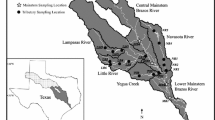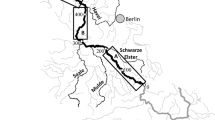Abstract
Five vessels, connected in series, were used for a continuous flow system to model carbon flow in anaerobic microbial communities. Two such 5-vessel systems were constructed, the inflows containing 10 mM sulfate and either 10 mM glucose or benzoate. Dilution was slow (D=0.0018 h−1 for the whole system).
Analyses of dissolved organic and inorganic carbon, and of CO2 and CH4, showed that the systems attained steady states in which biomass was constant, although there was net biosynthesis in the early vessels and net mineralization in succeeding vessels.
Examination of the distributions of sulfate reduction, methanogenesis, and of H2+CO2-utilizing fatty acid-forming bacteria revealed spatial separation of these functional groups of bacteria in different vessels of the array, resembling the vertical spatial separation found in many natural sediments. Such model systems should, therefore, prove valuable in investigating the many microbial activities that contribute to the flow of carbon in anaerobic microbial communities.
Similar content being viewed by others
References
Abram JW, Nedwell DB (1978) Inhibition of methanogenesis by sulphate reducing bacteria competing for transferred hydrogen. Arch Microbiol 117:89–92
Abram JW, Nedwell DB (1978) Hydrogen as a substrate for methanogenesis and sulphate reduction in anaerobic saltmarsh sediment. Arch Microbiol 117:93–97
Abson JW, Todhunter KH (1961) Plant for continuous biological treatment of carbonisation. Society of Chemical Industry Monograph 12:147–164
American Public Health Association (1976) Standard methods for the examination of water and wastewater, 14th ed. New York
Balba MT, Nedwell DB (1982) Microbial metabolism of acetate, propionate and butyrate in anoxic sediments from Colne Point Salt Marsh. J Gen Microbiol 128:1415–1422
Balch WE, Schoberth S, Tanner RS, Wolfe RS (1979)Acetobacterium: a new genus of H2 oxidizing CO2 reducing bacteria. Int J of System Bacteriol 27:355–361
Banat IM, Lindström EB, Nedwell DB, Balba MT (1981) Evidence for the coexistence of two distinct functional groups of sulphate-reducing bacteria in salt marsh sediment. Appl Environ Microbiol 42:985–992
Braun M, Schoberth S, Gottschalk G (1979) Enumeration of bacteria forming acetate from H2 and CO2 in anaerobic habitats. Arch Microbiol 120:201–204
Cappenberg TE (1974) Interrelations between sulfate-reducing and methane producing bacteria in bottom deposits of a freshwater lake. I. Field observations. Antonie van Leeuwenhoek J Microbiol Serol 40:285–295
Cooper DG, Copeland BJ (1973) Response of a continuous series of estuarine ecosystems to point source input variations. Ecological Monographs 43:213–236
Ferry JG, Wolfe RS (1976) Anaerobic degradation of benzoate to methane by a microbial consortium. Arch Mikrobiol 107:33–40
Kristjansson JK, Schönheit P, Thauer RK (1982) Different Ks values for hydrogen of methanogenic bacteria and sulfate-reducing bacteria. An explanation for the apparent inhibition of methanogenesis by sulfate. Arch Microbiol 131:278–282
Lovitt RW, Wimpenny JWT (1981) The gradostat: a bidirectional compound chemostat and its application in microbiological research. J Gen Microbiol 127:261–268
Nedwell DB (1982) The cycling of sulphur in marine and freshwater sediments. In: Nedwell DB, Brown CM (eds) Sediment microbiology. Academic Press, London, pp 73–106
Nedwell DB, Abram JW (1978) Bacterial sulphate reduction in relation to sulphur geochemistry in two contrasting areas of salt marsh sediment. Estuarine Coastal Mar Sci 6:341–351
Nedwell DB, Banat IM (1981) Hydrogen as an electron donor for sulfate reducing bacteria in slurries of salt marsh sediments. Microb Ecol 7:305–313
Reeburgh WS, Heggie DT (1977) Microbial methane consumption reactions and their effect on methane distributions in freshwater and marine environments. Limnol Oceanogr 22:1–9
Schönheit P, Kristjansson JK, Thauer RK (1982) Kinetic mechanism for the ability of sulfatereducers to outcompete methanogens for acetate. Arch Mikrobiol 132:285–288
Veldkamp H (1976) Continuous culture in microbial physiology and ecology. Meadow Field Press, England
Winfrey MR, Zeikus JG (1977) Effect of sulfate on carbon and electron flow during microbial methanogenesis in fresh water sediments. Appl Environ Microbiol 33:275–281
Wolin EA, Wolin MJ, Wolfe RS (1963) Formation of methane by bacterial extracts. J Biolog Chem 238:2882–2886
Author information
Authors and Affiliations
Rights and permissions
About this article
Cite this article
Thompson, L.A., Nedwell, D.B., Balba, M.T. et al. The use of multiple-vessel, open flow systems to investigate carbon flow in anaerobic microbial communities. Microb Ecol 9, 189–199 (1983). https://doi.org/10.1007/BF02097736
Issue Date:
DOI: https://doi.org/10.1007/BF02097736




